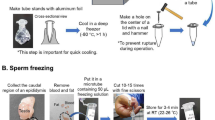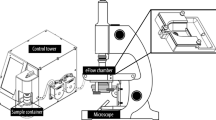Abstract
Purpose
The bioassay used by most IVF units to assess culture media is the mouse embryo test. The limitations of this assay are well known. The objective of this study was therefore to evaluate the in vitro bioassay potential of rodent sperm, in terms of relative sensitivities to endotoxins, and to compare the results with the routine mouse embryo and human sperm tests.
Results
The greater sensitivity of rodent sperm than of mouse embryos was evident in this study. A further advantage in using the mouse sperm test was the time (4–6 hr) in which endotoxins could be detected.
Conclusion
This rapid sperm test proved to be inexpensive, convenient, and invaluable for detecting potential sources of cytotoxicity.
Similar content being viewed by others

References
Dandekar PV, Glass RH: Development of two-cell mouse embryos in protein-free and protein-supplemented media. J Vitro Fert Embryo Transfer 1990;7:107–113
George MA, Doe BG: The influence and handling procedures during mouse oocyte and embryo recovery on viability and subsequent development in vitro. J Vitro Fert Embryo Transfer 1989;6:69–72
Naz RK, Janousek JT, Moody T, Stillman RJ: Factors influencing murine bioassay: Effects of proteins, aging of medium, and surgical glove coatings. Fertil Steril 1986;46:914–919
Sauer MV, Francis M, Macaso T, Paulson RJ: The effect of chemiluminescent light exposure on the in vitro development of mouse embryos. J Vitro Fert Embryo Transfer 1991;8:290–291
Wimmers MSE:Die invloed van Pseudomonas aeruginosa endotoksien op die ontwikkeling van muisembrios in vitro. MMed Sc Verhandeling, UOVS, 1991
George MA, Braude PR, Johnson MH, Sweetnam DG: Quality control in the IVF laboratory: In-vitro and in-vivo development of mouse embryos is unaffected by the quality of water used in culture media. Hum Reprod 1989;4:826–831
Randall GW, Gantt PA: Preimplantation murine embryos are more resistant than human embryos to bacterial endotoxins. J Vitro Fert Embryo Transfer 1990;7:280–282
Jackson KV, Kiessling AA: Fertilization and cleavage of mouse oocytes exposed to the conditions of human oocyte retrieval for in vitro fertilization. Fertil Steril 1989;51:675–681
Critchlow JD, Matson PL, Newman MC, Horne G, Troup SA, Lieberman BA: Quality control in an in-vitro fertilization laboratory: Use of human sperm survival studies. Hum Reprod 1989;4:545–549
Bavister BD, Andrews JC: A rapid sperm motility bioassay procedure for quality-control testing of water and culture media. J Vitro Fert Embryo Transfer 1988;5:67–75
Reed ML, Petters RM: An evaluation of hamster, rat, and mouse sperm-cell motility in media formulated with water of different qualities.
Rinehart JS, Bavister BD, Gerrity M. Quality control in the in vitro fertilization laboratory: Comparison of bioassay systems for water quality. J Vitro Fert Embryo Transfer 1988;5:335–342
Gorril MJ, Rinehart JS, Tamhane AC, Gerrity M. Comparison of the hamster sperm motility assay to the mouse one-cell and two-cell embryo bioassays as quality control tests for in vitro fertilization. Fertil Steril 1991;55:345–354
Snyman E, Van der Merwe JV: Endotoxin-polluted medium in a human in vitro fertilization program. Fertil Steril 1986;46:273–276
Author information
Authors and Affiliations
Rights and permissions
About this article
Cite this article
Esterhuizen, A.D., Bosman, E., Botes, A.D.E. et al. A comparative study on the diagnostic sensitivity of rodent sperm and embryos in the detection of endotoxin in earle's balanced salt solution. J Assist Reprod Genet 11, 38–42 (1994). https://doi.org/10.1007/BF02213696
Received:
Accepted:
Issue Date:
DOI: https://doi.org/10.1007/BF02213696



